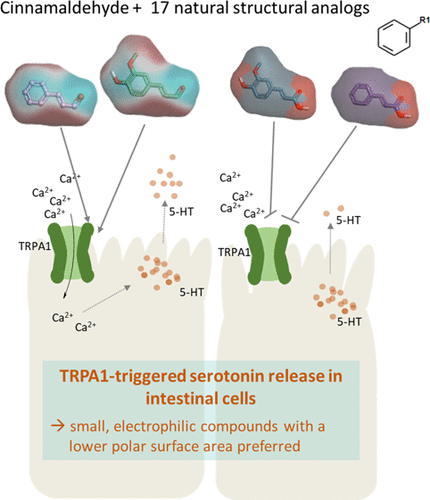当前位置:
X-MOL 学术
›
J. Agric. Food Chem.
›
论文详情
Our official English website, www.x-mol.net, welcomes your feedback! (Note: you will need to create a separate account there.)
Structure-Dependent Effects of Cinnamaldehyde Derivatives on TRPA1-Induced Serotonin Release in Human Intestinal Cell Models.
Journal of Agricultural and Food Chemistry ( IF 6.1 ) Pub Date : 2020-03-23 , DOI: 10.1021/acs.jafc.9b08163 Barbara Lieder 1 , Julia Hoi 1 , Nathalie Burian 1 , Joachim Hans 2 , Ann-Katrin Holik 1 , Leopoldo Raul Beltran Marquez 1 , Jakob P Ley 2 , Hanns Hatt 3 , Veronika Somoza 2
Journal of Agricultural and Food Chemistry ( IF 6.1 ) Pub Date : 2020-03-23 , DOI: 10.1021/acs.jafc.9b08163 Barbara Lieder 1 , Julia Hoi 1 , Nathalie Burian 1 , Joachim Hans 2 , Ann-Katrin Holik 1 , Leopoldo Raul Beltran Marquez 1 , Jakob P Ley 2 , Hanns Hatt 3 , Veronika Somoza 2
Affiliation

|
Activation of the transient receptor potential (TRP) channel TRPA1 by cinnamaldehyde has been shown to stimulate serotonin release in enterochromaffin QGP-1 cells. However, the impact of cinnamaldehyde on serotonin release in enterocytes is less well understood. In addition, since the neurotransmitter serotonin plays a regulatory role in a large variety of gastrointestinal and metabolic functions, it is of interest to study which structural characteristics determine cinnamaldehyde-induced serotonin release by enterocytes. Thus, the present study analyzed serotonin release in differentiated Caco-2 cells as a model for enterocytes in comparison to enterochromaffin QGP-1 cells after stimulation with cinnamaldehyde and 17 naturally occurring structurally related compounds by means of a serotonin ELISA. Stimulation with cinnamaldehyde induced a dose-dependent increase in serotonin release starting from 0.5 mM in both cell lines, with a larger effect size in Caco-2 enterocytes compared to that in QGP-1 enterochromaffin cells. Serotonin release in Caco-2 cells induced by additional 17 structurally related compounds correlated with serotonin release in QGP-1 cells, showing the highest effects for coniferylaldehyde with a 15.84 ± 3.23-fold increase in Caco-2 cells, followed by the parent compound cinnamaldehyde (13.45 ± 2.15), cinnamyl alcohol (6.68 ± 1.08), and α-methyl-cinnamaldehyde (6.59 ± 0.93). Analysis of structural and molecular characteristics that modulate serotonin release in Caco-2 enterocytes revealed that the ability of a compound to activate TRPA1, demonstrated by means of HEK293 cells transiently expressing hTRPA1, is a decisive factor to stimulate serotonin release in Caco-2 enterocytes, preferring small, electrophilic compounds with a lower polar surface area. In addition, blocking of TRPA1 using 30 μM AP-18 significantly reduced the cinnamaldehyde-induced serotonin release by 30.0 ± 5.24%, confirming a TRPA1-dependent component in serotonin release by Caco-2 cells.
中文翻译:

肉桂醛衍生物对人类肠道细胞模型中TRPA1诱导的5-羟色胺释放的结构依赖性影响。
已显示肉桂醛激活瞬时受体电位(TRP)通道TRPA1可刺激肠嗜铬细胞QGP-1细胞中5-羟色胺的释放。但是,肉桂醛对肠上皮细胞5-羟色胺释放的影响尚不十分清楚。另外,由于神经递质5-羟色胺在多种胃肠道和代谢功能中起调节作用,因此研究哪种结构特征决定肉桂醛诱导的5-羟色胺由肠细胞释放是有意义的。因此,本研究通过血清素ELISA分析了肉桂醛和17种天然存在的结构相关化合物刺激后,与肠嗜铬QGP-1细胞相比,作为肠上皮细胞模型的分化Caco-2细胞中的血清素释放。在两个细胞系中,肉桂醛刺激均会导致血清素释放的剂量依赖性增加,从0.5 mM开始,与QGP-1肠嗜铬细胞相比,Caco-2肠上皮细胞的效应更大。由另外17种结构相关化合物诱导的Caco-2细胞中5-羟色胺的释放与QGP-1细胞中的5-羟色胺的释放相关,对松柏醛具有最高的作用,在Caco-2细胞中增加15.84±3.23倍,其次是母体化合物肉桂醛(13.45±2.15),肉桂醇(6.68±1.08)和α-甲基肉桂醛(6.59±0.93)。对调节Caco-2肠细胞中5-羟色胺释放的结构和分子特征的分析表明,通过瞬时表达hTRPA1的HEK293细胞,该化合物具有激活TRPA1的能力,这是刺激Caco-2肠上皮细胞释放5-羟色胺的决定性因素,因此首选极性表面积较小的小型亲电子化合物。此外,使用30μMAP-18阻断TRPA1可使肉桂醛诱导的5-羟色胺释放降低30.0±5.24%,从而证实了Caco-2细胞释放5-羟色胺的TRPA1依赖性成分。
更新日期:2020-03-24
中文翻译:

肉桂醛衍生物对人类肠道细胞模型中TRPA1诱导的5-羟色胺释放的结构依赖性影响。
已显示肉桂醛激活瞬时受体电位(TRP)通道TRPA1可刺激肠嗜铬细胞QGP-1细胞中5-羟色胺的释放。但是,肉桂醛对肠上皮细胞5-羟色胺释放的影响尚不十分清楚。另外,由于神经递质5-羟色胺在多种胃肠道和代谢功能中起调节作用,因此研究哪种结构特征决定肉桂醛诱导的5-羟色胺由肠细胞释放是有意义的。因此,本研究通过血清素ELISA分析了肉桂醛和17种天然存在的结构相关化合物刺激后,与肠嗜铬QGP-1细胞相比,作为肠上皮细胞模型的分化Caco-2细胞中的血清素释放。在两个细胞系中,肉桂醛刺激均会导致血清素释放的剂量依赖性增加,从0.5 mM开始,与QGP-1肠嗜铬细胞相比,Caco-2肠上皮细胞的效应更大。由另外17种结构相关化合物诱导的Caco-2细胞中5-羟色胺的释放与QGP-1细胞中的5-羟色胺的释放相关,对松柏醛具有最高的作用,在Caco-2细胞中增加15.84±3.23倍,其次是母体化合物肉桂醛(13.45±2.15),肉桂醇(6.68±1.08)和α-甲基肉桂醛(6.59±0.93)。对调节Caco-2肠细胞中5-羟色胺释放的结构和分子特征的分析表明,通过瞬时表达hTRPA1的HEK293细胞,该化合物具有激活TRPA1的能力,这是刺激Caco-2肠上皮细胞释放5-羟色胺的决定性因素,因此首选极性表面积较小的小型亲电子化合物。此外,使用30μMAP-18阻断TRPA1可使肉桂醛诱导的5-羟色胺释放降低30.0±5.24%,从而证实了Caco-2细胞释放5-羟色胺的TRPA1依赖性成分。


























 京公网安备 11010802027423号
京公网安备 11010802027423号